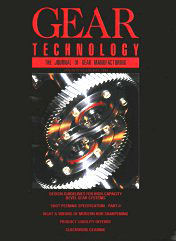The design of any gearing system is a difficult, multifaceted process. When the system includes bevel gearing, the process is further complicated by the complex nature of the bevel gears themselves. In most cases, the design is based on an evaluation of the ratio required for the gear set, the overall envelope geometry, and the calculation of bending and contact stresses for the gear set to determine its load capacity. There are, however, a great many other parameters which must be addressed if the resultant gear system is to be truly optimum.
A considerable body of data related to the optimal design of bevel gears has been developed by the aerospace gear design community in general and by the helicopter community in particular. This article provides a summary of just a few design guidelines based on these data in an effort to provide some guidance in the design of bevel gearing so that maximum capacity may be obtained. The following factors, which may not normally be considered in the usual design practice, are presented and discussed in outline form:
Integrated gear/shaft/bearing systems
Effects of rim thickness on gear tooth stresses
Resonant response
